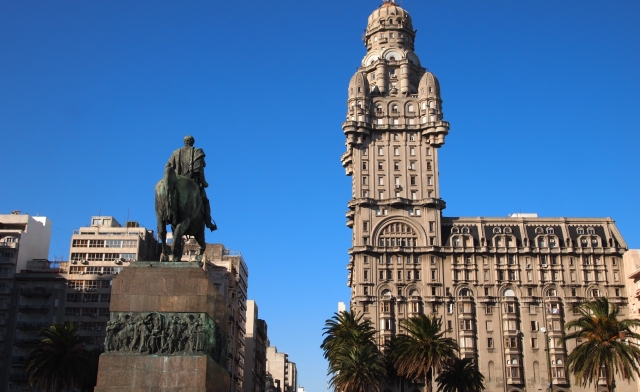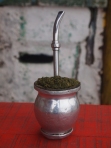Montevideo, Music, Meat and Maté

Uruguay is dominated with the four M’s: Montevideo (its capital city), music, meat and maté. As we found out neither is more important than the other, but they are all equally as vital to daily life in this proud country.
It all starts with Montevideo. We arrived in Uruguay’s capital, Montevideo, around midday after a two-hour bus ride from Colonia. Two girls, Graciela and Elise, had kindly agreed to host us for a couple of nights via couch surfing. Graciela is Uruguayan, while Elise is originally from Rouen in France.
We were greeted with a coffee and a chat by Graciela, who, in such a short space of time taught us much about Uruguayan life, culture and politics. We also learnt that, like many less-developed countries (and some developed countries for that matter), sustainable development is less important that quick economic gains.
A passionate greeny and self-declared revolutionary, Graciela informed us of the current polemic in parliament about the installation of a mining pipeline from the country’s inland to the tourism-centred coast, which is believed will destroy the coastal environment and habitats and degrade the natural assets Uruguay is so known for. We chatted for hours and were very grateful for her interesting insights into her country.
Montevideo isn’t the most beautiful of cities, but it does have life. Unfortunately, our first day there was spent hovering in a café in the old city while it poured down all day and night. If first impressions were the most important, ours were rather dampened by poor weather.
We did manage to fit in a visit to the Museo del Carnaval, which pays homage to Uruguay’s lively annual Carnaval, dwarfed only by Rio de Janeiro. Where once a year the streets come alive with music, festivities and costumes.
Candombé, traditional Uruguyan drumming once introduced by African slaves, is the main attraction at the Carnaval, which recognises the importance of African heritage to the country’s musical scene. Candombé is not only kept for Carnaval however, every Sunday in the streets behind 18 de Julio (the main drag), the barrio sur comes alive with the hypnotic sounds of the tambours.
The Sunday we were there happened to be the bicentennial of the country’s constitution – 18 July. We were fortunate enough to have a longer, bigger and more festive candombé parade than usual. As we approached we were summoned by the spellbinding beats that resonated the surrounding areas. This they call the llamada, or the call to come and join the festivities.
Traditionally, Sunday is the day because, as Uruguay was a primarily catholic nation, it was the only day of the week the slaves were freed from slavery, and they celebrated this liberation with music and songs.
Down in the historic old city we came across the Mercado del Puerto, smoke billowing from the many chimneys above. Once inside we were overwhelmed for choice of parilla restaurants, the typical BBQ (asado) on which sausages and meats of all cuts are literally thrown onto an inclining grill hovering above a traditional wood fire.
It may not be the most sustainable of food choices, but it certainly is a cultural one and worth a try. Argentina and Uruguay are known for their beef, and parrillas like these can be found in every barrio across the Río de la Plata. While the rain was pouring outside we sat down to a chorizo while the ‘sommelier’ served us a complimentary glass of sparkling wine called Medio y Medio – a market speciality.
Another tradition of liquid form is Maté. This potent herbal tea is the base of daily life, as it can be, and is taken everywhere. This tea is taken strong and in dedicated maté cups made from hollowed out gourds. Rare is the sight of a Uruguyan without his or her maté and thermos.
An Argentinean once told us that the Uruguayan’s primary pastime was drinking mate. Everywhere! “I once saw a family of four on a motorbike,” he said, “and the father was trying to steer while juggling a baby in one arm and his mate and thermos in the other.”
Loco!
There is one national obsession that doesn’t start with an M though – football. This we found out during the Copa America. This country is so football mad that the government formulated national campaigns around the ‘Celeste’ (the Uruguayan squad) to unite the people, as if by national identity. Uruguayans of all ages came together to support their national team.
During our time in Montevideo we witnessed a folly that could only be likened to a World Cup final – Uruguay vs. Argentina in the quarterfinal. We had chosen our spots early in a bar on 18 Julio to watch the madness unfold. The bar was packed to the rafters and goal after goal the excitement escalated. At every interval cries of ‘Ur-u-guay’ could be heard from every corner of the bar.
Uruguay won that match, and the streets of Montevideo went crazy. Cars suddenly came out onto the streets beeping and waving giant flags, firecrackers were exploding everywhere. People were screaming with joy and the celebrations continued into the early morning. We were later informed that not only were the people excited that their team won, but the main motivation for such exhilaration was because they beat the Argentinean team, the big rival and neighbour, in its own country.
This was only the start of our tour of the country that would not only include places but a look into a proud nation of the four ‘M’s and football fanatics.
Comments
4 Responses to “Montevideo, Music, Meat and Maté”Trackbacks
Check out what others are saying...-
[…] slave colonies they fought hard against their European aggressors and relieved their misery through music and dance, which has greatly influenced Bolivian culture and music […]
-
[…] in la Rocha with signage and protests on every corner denouncing the potential development of a mining pipeline here from […]















bravo Natasha pour ta prose et tes commentaires.Keep going to keep us abreast
Merci 🙂